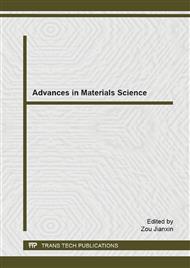[1]
W.F. SOARES, L.E. L. MELO; P.L.B. LISBOA, Anatomy of Five Wood Species Marketed as Sucupira, Floresta e ambiente. (2013).
Google Scholar
[2]
J.G.L. OLIVEIRA, J.T. S. OLIVEIRA, J.I.M. ABAD, A.G. SILVA, N.C. FIELDLER, G.B. VIDAURE, Anatomical structure measurements in eucalypt wood that grown in differents places, Revista Árvore. 36 (2012) 559-567.
Google Scholar
[3]
C.H. CALLADO, F.A. ROIG, M. TOMAZELLO FILHO, C.F. BARROS, Cambial growth periodicity studies of South American woody species – a review. IAWA Journal. 34 (2013), 213-230.
DOI: 10.1163/22941932-00000019
Google Scholar
[4]
G. CURY, M. TOMAZELLO FILHO, Anatomical Description of Wood Species Used in the Civil Construction, Floresta e Ambiente. 8(2011) 227-236.
Google Scholar
[5]
A.C. LISBOA, P.S. SANTOS, S.N. OLIVEIRA NETO, D.N. CASTRO, A.H.M. ABREU, Effect of volume of tubes on the production of seedlings of Calophyllum brasiliense and Toona ciliata, Revista Árvore. 36 (2012) 603-609.
DOI: 10.1590/s0100-67622012000400003
Google Scholar
[6]
A.R. BRENES, F. MONTAGNINI, Growth, productivity, aboveground biomass, and carbon sequestration of pure and mixed native tree plantations in the Caribbean lowlands of Costa Rica, Forest Ecology and Management. 232 (2006) 168-178.
DOI: 10.1016/j.foreco.2006.05.067
Google Scholar
[7]
P. CIRIELLO, Macroscopic anatomical characterization of Woods used for lamination in the region of Curitiba-PR, Referência. 11 (2009) 39-45.
Google Scholar
[8]
D.I. URZEDO, M.P. FRANCO, L.M. PITOMBO, J.B. CARMO, Effects of organic and inorganic fertilizers on greenhouse gas (GHG) emissions in tropical forestry, Forest Ecology and Management. 310 (2013) 37-44.
DOI: 10.1016/j.foreco.2013.08.018
Google Scholar
[9]
P. E.R. CARVALHO, Amazon Cerejeira (Amburana acreana) Taxonomy and nomenclature, Embrapa florestas. 134 (2007) 1-6.
Google Scholar
[10]
S. S. AMARAL, Anatomical characterization of the Guanandi wood. Monography- Unesp. (2010) 58.
Google Scholar
[11]
V. T. R. CORADIN, G. B. MUNIZ, Rules of procedures in wood anatomy studies: I. Angiospermae. II. Gimnospermae, IBAMA. (1992).
Google Scholar
[12]
IAWA COMMITTEE, List of microscopic features for hardwood identification, IAWA Bulletin. 10 (1989) 219-332.
Google Scholar
[13]
G.I.B. MUÑIZ, S. NISGOSKI, F. Z. SHARDOSIN, R.F. FRANÇA, Charcoal anatomy of forest species, Cerne. 18 (2012) 471-477.
DOI: 10.1590/s0104-77602012000300015
Google Scholar
[14]
H.G. RICHTER, M.J. DALLWITZ, Commercial timbers: descriptions, illustrations, identification, and information retrieval. (2000). Information on http: / delta-intkey. com/wood/pt/www/gutcabra. htm.
Google Scholar
[15]
C. MAINIERI, J.P. CHIMELO, Data sheets of characteristics of Brazilian woods, IPT, São Paulo, 1989, 418 p.
Google Scholar
[16]
A.V. STEPANOVA, A.A. OSKOLSKI, P.M. TILNEY, B.E. VAN WYK, Wood anatomy of the tribe Podalyrieae (Fabaceae, Papilionoideae): Diversity and evolutionary trends, South African Journal of Botany. 89 (2013) 244-256.
DOI: 10.1016/j.sajb.2013.07.023
Google Scholar
[17]
J. ZHENG, H.I.M. CABRERA, Wood anatomical correlates with theoretical conductivity and wood density across China: evolutionary evidence of the functional differentiation of axial and radial parenchyma, Annals of Botany. 112 (2013) 927–935.
DOI: 10.1093/aob/mct153
Google Scholar


